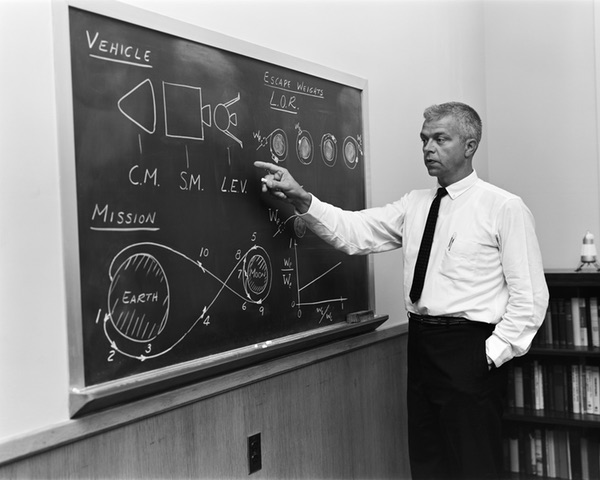“Do we want to get to the Moon or not?” (part 1)Dr. John C. Houbolt and the decision for lunar orbit rendezvousby Carl Alessi
|
| For Houbolt, the key to making a Moon landing happen was to overcome the problem of weight by using orbital rendezvous. |
As the Cold War developed, it was Langley Research Center that became a worker’s hive for some of the free world’s best and brightest, not only in aviation, but also the invent-as-we-go field of astronautics in the late 1950s. One engineer working in that new frontier was a man named John C. Houbolt. Born on April 10, 1919, and raised on a farm in Joliet, Illinois, into a family of immigrants from the Netherlands, young John grew up “working 16 hours a day, milking cows in the morning at 20 below zero and everything.”2 As a boy, Houbolt’s early gift for mathematics manifested itself in the equations he would sketch out “on grocery bags, envelopes, even on the sides of bathtubs while taking a bath.”3
His talents led him to achieve both a bachelors degree in 1940 and a masters in 1942, both in civil engineering; it was in 1942 that he went to work at Langley for the first time. Houbolt focused on the study of aeronautical loads on aircraft, and by 1949 he became Langley’s assistant chief of the Dynamics Loads Division. In 1958, Houbolt obtained his doctorate in technical sciences from the Swiss Federal Institute of Technology in Zurich with his dissertation on the effects of high-speed flight and the heating of aeroelastic structures. By 1958, Houbolt was looking beyond flight in the air to flight in space, which increasingly fascinated him. But it wasn’t getting into space that compelled his analytical streak. Instead, it was a theory. This theory fixed his thoughts in a single direction: the Moon. And it was his adherence to the obvious scientific validity of that theory that led him into political and professional trouble.
At Langley, 1958 was also a significant year of change as the newly-born NASA took over. The NACA was gone: space was now part of Langley’s mandate, and engineers that had spent most of their time on airfoils and jet engines now started conceptualizing plans for the United States that involved the use of rocket engines and spacecraft. The Space Task Group (STG) took on the enormous responsibility for the nation’s first manned space program, known as Project Mercury. Names that would become legends in the industry, such as Max Faget, Chris Kraft, and Gene Kranz, became founding members of the STG as they invented the means and hardware to put men into Earth orbit, and thus hopefully do what no one had done before them. Around the country, new groups took shape, gathered personnel, and were harnessed under NASA’s umbrella: in 1960 the Army’s Redstone Arsenal at Huntsville, Alabama, was transformed into NASA’s Marshall Space Flight Center under its director Wernher von Braun, with the continuing responsibility of developing large rocket boosters.4 The Jet Propulsion Laboratory in California, the Goddard Space Flight Center in Maryland, the Lewis Research Center in Ohio—all these and more were to be administered under NASA’s headquarters in Washington, DC.
These field centers had many projects to manage within the constellation of NASA’s mandate for both aviation and space. Along with the specific advancement of Project Mercury, NASA also looked beyond to possible missions and applications for the nation’s future in space. Orbiting stations were envisioned, as were flights to the vicinity of the Moon. It was the possibility of lunar flight that led in 1960 to the creation at Langley of the Lunar Mission Steering Group. Different committees under this group would study various aspects of a flight around the Moon and back to Earth, although landings on the lunar surface were not specifically addressed at this level. Landings on the Moon became the focus of a committee within the group, the Lunar Trajectory Group, which analyzed landing vehicle sizes and weights.
Sizes and weights: For Houbolt, the key to making a Moon landing happen was to overcome the problem of weight by using orbital rendezvous. Rather than lifting one huge mass on one big rocket, two or more mission components launched on smaller rockets would meet in orbit, mechanically embrace each other, then become whatever you needed them to be—a space station, or a spaceship carrying men to the Moon, or a lander that took them to the lunar surface itself.
| But in another sense, rendezvous posed a counterintuitive challenge. Quite simply, no one had ever done it before. |
In one respect, bringing separate components together in space became particularly obvious when the problem was viewed from the vantage point of 1960. At that time, the largest rocket boosters in the American inventory were few in type and lacking in robust lifting capacity. Intercontinental ballistic missiles such as Titan I and Atlas D, the largest operational boosters of the time, had the ability to place a maximum of roughly 1,350 kilograms into low Earth orbit.5 A ship bound for the Moon would need to weigh a lot more and travel a lot farther by moving faster than any spacecraft before it—over 250,000 kilometers farther, over 11,000 kilometers per hour faster. and perhaps 70,000 kilograms heavier.
But in another sense, rendezvous posed a counterintuitive challenge. Quite simply, no one had ever done it before. Most engineers and theoreticians felt that rendezvous in Earth orbit should be possible; indeed multiple studies were underway on the subject, not only at Langley, but at other NASA centers. Even private entities such as Vought Astronautics6 had conducted extensive studies on rendezvous, beginning in 1958.
Since the launch of Sputnik in that same year, John Houbolt’s thinking had been directed towards rendezvous applications. Consequently, he headed the rendezvous committees within Langley’s Lunar Mission Steering Group. But while that group’s mandate was to study the “what ifs” of a voyage around the Moon and back again, Houbolt was not bound by any such conceptual restrictions. Instead, his studies were targeted toward an actual manned, lunar landing.
The great mode debate
By 1960, a program to follow Project Mercury was already taking shape within NASA. In that year before Alan Shepard took his first fifteen-minute flight into space, plans for space stations and lunar missions were pushed and pulled between committees for the Mercury follow-on spacecraft, commissioned as “Project Apollo” in July.7 By that time, three schools of thought were taking shape on the best way to land men on the Moon.
Direct Ascent. The concept seemed as simple and efficient to many within NASA as it did to Jules Verne or H.G. Wells: launch a ship directly to the Moon. Don’t waste time orbiting it, just land. When you’re done, lift off again, get out of Dodge and head home. Reenter the Earth’s atmosphere and splash down in the same manner as a Mercury capsule.
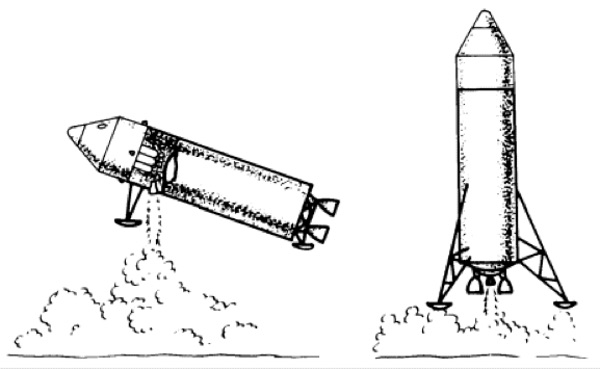 Two landing configurations considered for the Direct Ascent Mode. (credit: NASA) |
Except the spacecraft involved would be no Mercury capsule. It would be large, shielded, and heavy. The moonship/lander itself might be on the order of 25 meters tall. And it would require an enormous rocket to boost it from the Earth. This rocket, known as Nova, would be so massive and complex that it would dwarf anything currently envisioned for any other mission conceptualized by NASA. Nonetheless, the concept seemed so straightforward that Nova was submitted to President Eisenhower for review in 1959.8
Earth Orbit Rendezvous. Many engineers realized the daunting problems with direct ascent, chiefly with producing a rocket that would be so huge it could overwhelm both NASA’s capabilities and the country’s infrastructure for building and transporting Nova’s components to the launch site. “EOR” solved those problems by relying not on a single super-booster, but multiple smaller rockets to lift the necessary flight components to Earth orbit. In that environment, the spacecraft components would rendezvous and be brought together for final assembly. The completed vehicle would then fly straight to the Moon and land in a direct ascent profile, lifting off later from the surface and returning to Earth.
This concept had a lot of support within NASA, and much of that support came from people with a lot of sway: Wernher von Braun and his team of designers at the Marshall Space Flight Center were proponents of EOR, which would provide them with the opportunity to use their new Saturn-class launchers then undergoing initial construction. However, the risk with EOR chiefly circled around the word rendezvous. Remember, no one had ever performed one before. Not the Americans, nor the Soviets. No one.
| “I realized rendezvous was essential to all space flight,” he later said. “You don’t know how it comes to you. You know, you just get an idea in the morning, while you’re brushing your teeth. I just felt it.” |
Lunar Orbit Rendezvous. This mode is where the thinking of men like Houbolt was directed. You might use multiple rockets to assemble your spacecraft in Earth orbit. Or you might dispense with the idea of multiple rockets and commit to the simplicity of a single booster, but a manageable one smaller than Nova. But the critical factor—the idea that was truly revolutionary in its audacity—was to use smaller rockets by eliminating the illogical requirement of landing a heavy, huge, heat shielded ship on the moon, which would include engines powerful enough to lift it later from the lunar surface. Instead, you would detach a lightweight, specialized lander from that heavy Apollo spacecraft, land it, and then launch it back again to rendezvous in lunar orbit with the Apollo mothership for a safe return to Earth. The lander would never need to completely escape the Moon’s gravity well; it would just need an engine with sufficient power and weight to get it back into lunar orbit for rendezvous with the mother ship.
However, LOR held minority support within the aerospace community in general. Why? Again, because of that magic word “rendezvous.” That a Moon landing mission might be aborted because a rendezvous might fail in Earth orbit was worrisome enough; to risk the entire mission and one or more astronaut’s lives in the unknown environment of the moon was a leap into darkness, blindfolded with eyes squeezed shut.
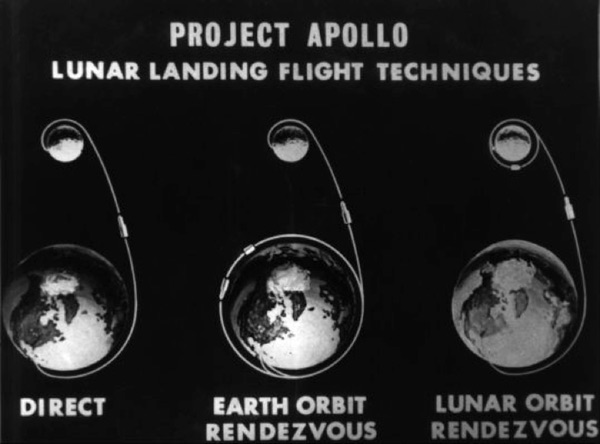 Diagram of the various modes considered by NASA in 1960. (credit: NASA) |
John Houbolt saw things differently. “I realized rendezvous was essential to all space flight,” he later said. “You don’t know how it comes to you. You know, you just get an idea in the morning, while you’re brushing your teeth. I just felt it.”9 For Houbolt and others, the savings in weight for not flying a heat-shielded mother ship on and off the Moon’s surface were so substantial that LOR was the only logical candidate strategy. “Almost simultaneously, it became clear that lunar orbit rendezvous offered a chain reaction simplification on all ‘back effects’: development, testing, manufacturing, erection, countdown, flight operations, etc.”10
Houbolt was not the only engineer to realize this. Within Langley’s steering group, an engineer named William Michael had already composed and circulated a monograph titled “Weight Advantages of Use of Parking Orbit for Lunar Soft Landing Mission.”11 His two-page paper provided a high-level overview of the advantages of achieving lunar orbit first, then leaving unnecessary components in that orbit before attempting a landing. He concluded that “50 percent” of the lunar spacecraft’s weight could be eliminated by not landing the entire vehicle on the Moon and lifting it off again. But Houbolt’s calculations were becoming far more elaborate and specific than Michael’s: his conclusions led him to a final weight savings factor of “2 to 2.5”.
Michael’s two-page concept paper showed that the idea of modularizing spacecraft for a lunar mission was getting some traction. But on the very morning that his paper was published, Michael walked into a rude awakening in the form of a presentation offered by a team from Vought Astronautics. This group, led by Thomas Dolan and with no connection to any team at Langley, gave a detailed presentation to Michael and his people about vehicle designs that could be used to follow up on Project Mercury. Entitled MALLAR—Manned Lunar Landing and Return—it represented not two pages, but two years’ worth of research in the best way to land men on the Moon. In detail, Dolan’s group laid out for the Langley people in the room all the benefits for a specialized spacecraft to be used for a Moon landing, including the use of a specialized, disposable craft to be used solely for that landing and return from the surface to lunar orbit. For the next several days, Michael walked around “with his face hanging down to the floor” recalled one of Langley’s division heads, Clinton Brown, because of the detail they articulated regarding their idea of “designing a spacecraft so that you can throw away parts of it as you go along.” As Brown pointed out, “They had scooped us.”12
As 1959 progressed into 1960 it had become obvious that the progenitors of rendezvous were numerous and varied throughout the burgeoning aerospace community. Quite simply, the horizon line of future development illuminated one inescapable fact: rendezvous was going to be indispensable to ongoing operations in the theater of space. You simply could not avoid making a space station or a Moon base a reality if you stayed glued to the idea of putting everything up on one rocket in one piece. Within Langley’s Space Task Group, committees were formed that were tasked with the future of space development beyond Project Mercury, and these committees, in turn, split into subcommittees. With different purposes but overlapping concerns, they turned their focus towards the mechanics and application of rendezvous, and there was a great deal of in-house talk between them. While some of those conversations gained little headway against the risks involved, the sheer necessity of rendezvous shaped their direction, and the math involved made that direction appear doable.
“He doesn’t know what he’s talking about”
What Houbolt would need was the opportunity to advance his case farther than the middle latitudes of Langley’s engineering committees. In September 1960, that opportunity literally walked in the door at Langley in the guise of NASA’s new Associate Administrator, Robert C. Seamans.
| In general, Houbolt remembered, everyone at both talks seemed to listen. No one disagreed with him—and no one agreed with him either. |
Seamans, who had been a chief engineer working on missile interceptor programs for the Air Force under contract with RCA,13 came to NASA on September 1 in no small part because of his background in rendezvous applications.14 He began his introduction to NASA by touring its various field centers, including Langley. Houbolt met with Seamans and made sure that he knew his thoughts about rendezvous—particularly LOR—during that visit. Seamans, who was well-disposed towards the future usefulness of rendezvous, was quite receptive. In the end, Seamans invited Houbolt to present his ideas concerning rendezvous to NASA Headquarters in Washington. A door, it seemed at last, had finally opened.
Houbolt’s reputation as the man when it came to rendezvous continued to gain ground within aerospace circles. Prior to the Washington briefing, he gave lectures on the subject to both the Air Force Scientific Advisory Board at the Pentagon and to the Space Task Group at Langley.15 Throughout those talks, Houbolt pressed his contention that rendezvous had a broad-based utility for space: for earth orbiting stations, satellite servicing, the Moon—for almost everything. And at the apex of those discussions surrounding the Moon was that big idea of that little lunar landing craft that could reach the Moon’s surface, leaving its large mother craft in lunar orbit.
Through diagrams, verbal descriptions and figures, Houbolt pointed out the critical savings in weight the initial boosters would have to contend with when lifting their payloads from the Earth if the lander were as specialized and light as possible. Houbolt later stated, “We would put up a component with a first booster; we would put up another component with another booster; then we would rendezvous the two of them in Earth orbit. Then we would go to the Moon with this booster system and perform the lunar-orbit rendezvous with the remaining spacecraft.”16 His recognition in 1960 for an Earth orbit rendezvous component was based on the reality that the boosters in America’s arsenal were limited in their size and lifting capacity. But if a rocket could be made large enough, the EOR portion could be done away with: everything could be launched on a single, large booster. The only rendezvous necessary would be the one in lunar orbit.
In general, Houbolt remembered, everyone at both talks seemed to listen. No one disagreed with him—and no one agreed with him either. The wall of apathy irritated Houbolt, but perhaps the lecture at NASA Headquarters scheduled for December 14 would finally elicit a reaction from people who were influential and who cared to speak up. And it did.
One of the people who had been at the Space Task Group briefing was an engineer by the name of Max Faget. Although not as well known to the public as Wernher von Braun (who had shrewdly developed a public relations campaign by collaborating with Walt Disney), Faget held a status that was similar to von Braun’s within NASA. He had joined Langley in 1946. It was Faget who was instrumental in designing the Mercury spacecraft—the escape tower in use on that vehicle had been Faget’s idea. He had worked on the X-15. He had recently been appointed Chief of the Flight Systems Division at Langley.17 He had said very little at Houbolt’s earlier briefing at Langley. Now, the wiry, balding figure with a bow tie strode into the room, took his seat and listened.
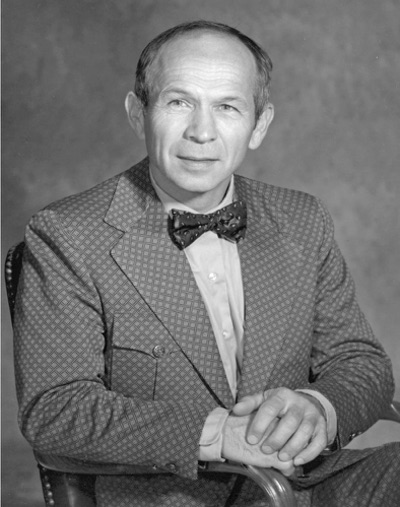 Max Faget. (credit: NASA) |
Houbolt looked out on his audience: along with Faget, he saw Robert Seamans, NASA Administrator T. Keith Glennan, and Wernher von Braun. With his usual deliberation, Houbolt laid out his plans for landing on the Moon with a dedicated, separate craft that would rendezvous later with its heavier Apollo mothership. He placed before the group his supporting figures, once again asserting that the initial weight of the payload that any booster, or boosters, would have to lift could be reduced by a factor of 2 to 2.5 by using Lunar Orbit Rendezvous.
And then, Max Faget stood up.
“His figures lie!”
No one else spoke. And everyone turned to watch, because Faget wasn’t done. “He doesn’t know what he’s talking about!”
And there it was. In front of NASA’s senior management, Faget had just summed up what engineers throughout the network had been thinking all along, and still were.
To be fair, Faget’s challenge and the doubt that it framed were not without some intuitive foundation: Lunar Orbit Rendezvous required not one space vehicle, but two. Two computer systems, not one; two environmental control systems, two propulsion systems; two of almost everything that mattered, all in the name of saving weight.
Right.
| It was now evident that with a commitment to reach the Moon, NASA could not go forward without a selection of a mode. |
Houbolt was ready for these arguments, of course. He would cite, once again, that the true weight savings came from not landing the combined weight of a multipurpose vehicle on the Moon and lifting it off the surface again, but landing only the lighter one. He also pointed out that two vehicles had an inherent advantage: if one had a catastrophic failure, you could press the remaining ship into a “lifeboat” contingency to replace the failed ship’s lost functionality (foreseeing what happened to, and later saved, the crew of Apollo 13).
It didn’t matter. The briefing ended. The room was not swayed one way or the other, and a final consensus on the matter once again drifted in limbo.
May 25th, 1961
“I believe that this nation should commit itself,” President Kennedy proclaimed on that day to Congress, “to achieving the goal, before this decade is out, of landing a man on the Moon and returning him safely to the Earth.”
We view those words today as images in a black and white film as Kennedy spoke in his clear and matter-of-fact cadence. But how we would go to the Moon was anything but black and white. Regardless, and with amazing political suddenness, we were committed. We were going to the Moon. And the clock that counted off the minutes till the end of the decade was now ticking.
With the goal of a lunar landing having been declared, the center of gravity regarding how we could achieve that goal organized itself around a fresh cluster of committees, groups, and task forces. Because the direct ascent mode was relatively well understood regarding its assets and liabilities, an early focus was cast on the unknowns circling around rendezvous. In July of 1961, the Large Launch Vehicle Planning Group was created to study the underlying problem constraining every lunar mode on the table: America’s rockets and their limited lifting capabilities. This committee, known colloquially as the Golovin Committee for its NASA chair, Nicholas E. Golovin (the committee was co-chaired by Lawrence L. Kavanau from the Department of Defense), split itself among three field centers for areas of study: the Marshall Spaceflight Center for EOR; Langley, who under Houbolt’s direction would propose LOR; and the Jet Propulsion Laboratory who would look into something called “Lunar Surface Rendezvous”18 . This last mode would place return-to-Earth elements on the lunar surface, have the astronauts assemble them there, and fly back to Earth in the new vehicle. (Yes: it was 1961, and they really thought of doing that. Houbolt would later describe this as “one of the most hair-brained [sic] ideas I have ever heard.”)19
The committee rapidly bogged down into a debate between the utility of liquid-fueled Saturn-class rockets that were favored by von Braun’s people at Marshall, and solid-fueled rockets preferred by representatives of the Army and Air Force. Golovin himself favored liquid-fueled boosters, but trusted the direct ascent mode over any mode featuring rendezvous. Most committee members, however, leaned toward rendezvous.
It was now evident that with a commitment to reach the Moon, NASA could not go forward without a selection of a mode. And they could not go forward with a mode until we selected a booster. And they could not select a booster without a compatible mode.
In September, the Director of the Space Task Group, Robert Gilruth wrote, “[T]he rendezvous approach itself will, to some extent, degrade mission reliability and flight safety. I am concerned that rendezvous schemes may be used as a crutch to achieve early planned dates for launch vehicle availability, and to avoid the difficulty of developing a reliable NOVA class launch vehicle.”
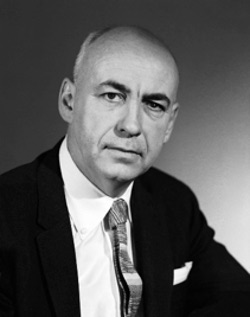 Dr. Robert R. Gilruth. (credit: NASA) |
True consensus eluded almost everyone. And then, a development occurred that finally must have seemed to Houbolt like a burst of water in this desert of bureaucratic confusion: on October 10, the Golovin Committee issued a report from its field centers. Lunar Surface Rendezvous was out. Direct ascent was discounted, because of the requirements for a Nova booster that would simply take too long to develop.
| If you feel so strongly about Lunar Orbit Rendezvous, Heaton told Houbolt, perhaps you should submit your own minority report outlining why. |
Earth Orbit Rendezvous and Lunar Orbit Rendezvous—one of the two—should be considered for achieving a lunar landing to meet the President’s directive. Of the two, LOR offered the quickest path to a landing because of its dedicated landing module, but it was laced with more unknowns and risks than any other mode.
Sensing some initiative, Houbolt than reached out to the chair of another committee where he was a member, one focusing on boosters and rendezvous modes. Colonel Donald H. Heaton, who was assistant director of Launch Vehicle Programs at NASA Headquarters, had issued a report in August strongly favoring EOR using von Braun’s proposed Saturn C-4 launch vehicle (which would include four F-1 engines in the first stage) to minimize the number of required launches to assemble the proposed moonship.20
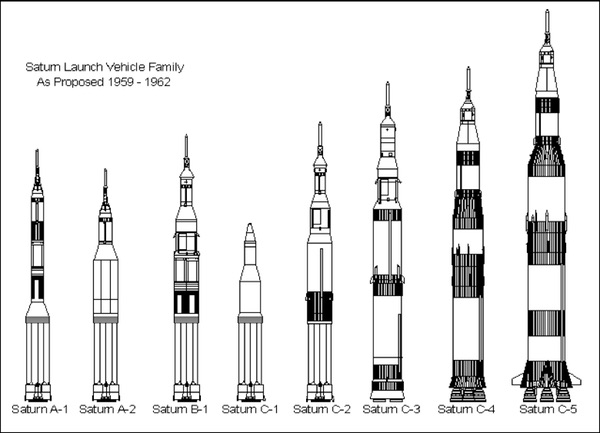 Proposed Saturn C-class launch vehicles (credit: Mark Wade/Astronautix.com) |
No. Heaton was firm in his refusal: his committee had been charged with considering Earth Orbit Rendezvous. That was their charter. No other mode was within their purview.
Houbolt argued again that he was not against EOR, but that he was simply opposed to any mode that completely excluded LOR as an ultimate landing modality.
No, Heaton maintained. Lunar Orbit Rendezvous is not part of this committee’s charter. Then Heaton did something unusual—he cracked the door ever so slightly for Houbolt. If you feel so strongly about Lunar Orbit Rendezvous, perhaps you should submit your own minority report outlining why.
Endnotes
- Tom Crouch, Langley History, accessed April 22, 2014.
- Susan M. Sadowsky-Harvey and Robert E. Sterling, The Soaring Achievements of John C. Houbolt. CreateSpace Independent Publishing Platform (May 13, 2009)
- Earl Barnes, Washington Post, April 30, 2014
- Marshall Space Flight Center (MSFC).
- History.NASA.gov, Astronautics And Its Applications, Part II, Technology, Section 19 D, Atlas and Titan.
- Courtney G. Brooks, James M. Grimwood, Loyd S. Swenson, Chariots for Apollo, Chapter 3, page 66.
- Ibid, page 15
- Encyclopedia Astronautica. “Nova”.
- John M. Eade, The Daily Press, “Engineer Had Rendezvous With History”.
- James R. Hansen, Enchanted Rendezvous, page 15.
- William H. Michael, Jr., Weight Advantages of Use of Parking Orbit for Lunar Soft Landing Mission, in Jack W. Crenshaw et al., “Studies Related to Lunar and Planetary Missions,” Langley Research Center, 26 May 1960, pp. 1-2
- Hansen, 10-11
- On The Shoulders Of Titans, Chapters 1-3, Challenge From The Field.
- Ibid.
- Hansen, Enchanted Rendezvous, page 16
- Ibid
- Encyclopedia Astronautica. “Max Faget”
- Hansen, Enchanted Rendezvous, page 32
- John C. Houbolt, letter to Robert Seamans, November 15, 1961, page 4
- Heaton, Donald Haynes, Col Deceased, Air Force, Together We Served
